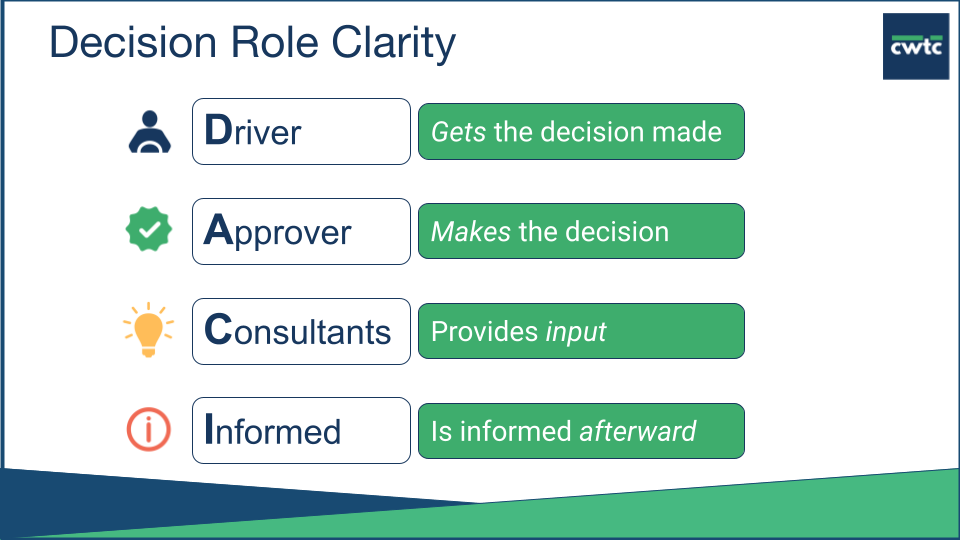
Does decision-making in your organization sometimes look like “bunch ball”—you know, when young soccer players swarm the ball, don’t pass, and don’t play positions? Debbie and I have worked with organizations large and small where too many people want to be involved in every decision.
The result, as you may have experienced, can be frustrating, painful decision-making. If you recognize any of these symptoms in your organization, you may be suffering from “bunch ball” decision-making:
- Decision delay: Getting input and buy-in from everyone takes forever, possibly without a clear decision owner.
- Decision swirl: Decisions are made but then revisited, sometimes more than once.
- Decision tunnel vision: Decisions are made in silos, without understanding the upstream and downstream impacts.
So what’s the winning game plan? How do you help your organization outgrow “bunch ball” decision-making and become World Cup decision-makers? As with successful soccer teams, everyone has to know their position and play it well. It’s all about roles and responsibilities!
Meet the Players

Of the several decision-making frameworks we’ve seen in action, we use a Driver, Approver, Consultants, and Informed (DACI) model for its simplicity and flexibility in laying out each role’s responsibilities. (Note: This is a scalable process. You can identify roles quickly, often in your head, with no burdensome overhead.)
- The Driver guides the decision-making process.
- The Approver makes the final call and is accountable for the outcome.
- The Consultants provide data and advice to ensure a sound decision.
- The Informed are told about the decision but do not have a say.
For DACI to work, everyone must play their position. “Stay in your lane!” was what one of our clients exhorted. Beyond that general principle, here are some tips for each role in a moderate-to-complex decision.
If you’re the Driver, you make sure the decision moves forward. Engage the Approver. Cast a wide net to ensure all Consultants are identified and then ruthlessly edit down the list to only key Consultants. Get clear on how decision choices will be identified and evaluated. In complex decisions, you may also be the one to collect input from the Consultants and evaluate them for the Approver. Your efforts are critical to getting a timely, effective decision made.
If you’re the Approver, be available to the Driver to review DACI roles, discuss the context and desired outcomes of the decision, help identify evaluation criteria to be used, review the Consultants’ input, and whatever else is important for reaching a sound decision. You’re accountable for the decision and its outcome, so help the Driver help you.
If you’re a Consultant, remember that you don’t have veto power. You provide your expertise, opinion, data, or other input and trust the Approver to consider your contribution in combination with the rest of the input collected.
Informed? You’re only a spectator even if you care deeply about the outcome. When you hear the decision, you’ll want to model acceptance and responsiveness.
Sizing Your DACI
Of course, you’ll want to adapt DACI to your specific needs. Like in a simple backyard scrimmage, sometimes one person plays multiple roles. In a limited-scope decision such as a department website redesign, the Driver and Approver could be the same person. For a big, complex decision like where to relocate an office or in which market to first launch a product, there might be a lot of information to collect, many people involved, and the need for a dedicated Driver to manage the process and provide a recommendation to the Approver.
SCORE: Your Team: 1 Painful Decision-Making: 0
When the players identified in the DACI framework work effectively together, your decisions are made without delay, are revisited only with good reason, and balance all stakeholder needs. DACI for the win!
We’ve got a wealth of resources, activities, and workshops designed to help improve your organization’s decision-making. If you enjoyed these tips, sign up for our newsletter so you don’t miss a future post or learning event announcement.
CW Training and Consulting specializes in hands-on, interactive project management related skills boosting workshops - either off the shelf or customized to your needs. Contact Us and we'll help you find the right learning solution for you and your business.
